When most of us hear the word ‘wasp,’ we think of those angry insects with stingers that hurt like crazy. However, despite most people’s hatred of them, wasps are great for the ecosystem because they eat lots of other pests that we hate just as much as the wasps.
So, what do wasps eat? Different species of wasps eat various things, but as a whole, they enjoy nectar, plants, honey, fruit, and food left in the garbage to rot. Wasps also eat insects, such as cicadas, ants, flies, aphids, grasshoppers, beetles, and bees. Some of them may consume spiders, caterpillars, and even dead things.
This article will teach you to identify different types of wasps and their nests. It’ll also cover various wasp species’ feeding habits and touch on ways to eliminate unwanted wasps. Keep reading to learn more about these fascinating, flying insects.
Wasp Identification Guide
There are over 30,000 species of wasps worldwide, so learning to identify all of them would be a daunting task. However, there are still many things we can learn about wasps without trying to memorize all of them. Here are some information you can store:
What Is a Wasp?
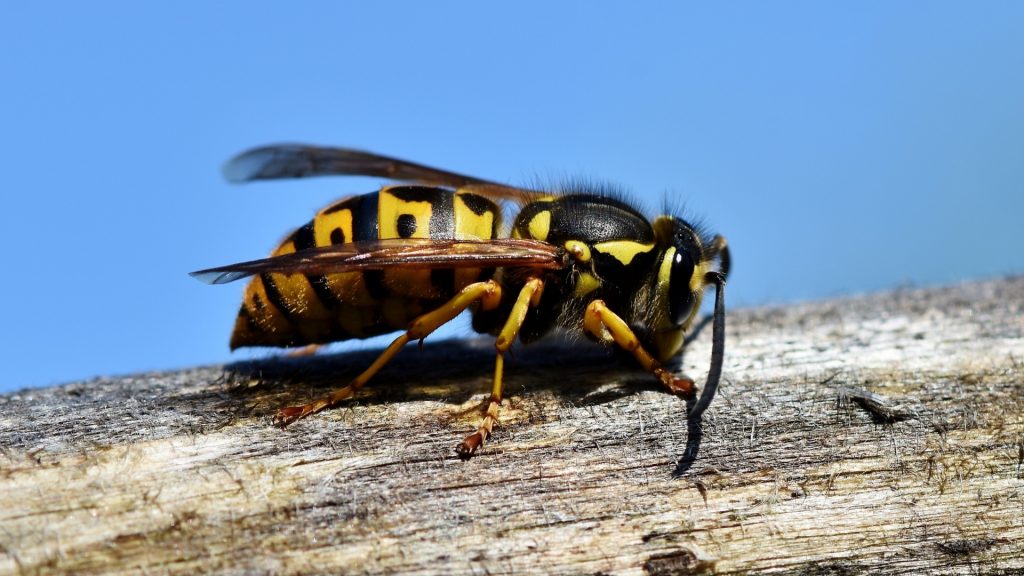
Wasps are flying insects that belong in the order Hymenoptera, along with bees and ants. Despite not being as efficient as bees, wasps are still important pollinators. In fact, there are 164 plants that solely rely on wasps for pollination, including fig plants.
Aside from pollination, wasps also help disperse seeds, control pests, and decompose carcasses. They are widely misunderstood due to their stinging prowess and the misconception that they are aggressive. In truth, most wasps only sting as a means of defensive behavior!
What Does a Wasp Look Like?
Because there are thousands of identified wasp species, there isn’t a single answer to this question. Wasps vary in size and color; however, they all have a few things in common. For example, all wasps have:
- Hard exoskeletons
- Three-segment bodies (head, thorax, and abdomen)
- Six jointed legs
- Long segmented antennae
- Four developed (usually translucent) wings
- Compound eyes
- Narrow waists
- Hairless or nearly hairless bodies
Beyond that, wasps can look wildly different. Their colors range from black and other dull, earthy colors to bright, vibrant colors like bright yellow, emerald green, and metallic purple. They range in size from 0.5 mm (0.02 in) to over 50.8 mm (2 in) long.
Most female wasps have stingers, but most don’t sting unless threatened, and many won’t sting humans or animals even then, using their stingers only for hunting prey.
What Does a Wasp Nest Look Like?
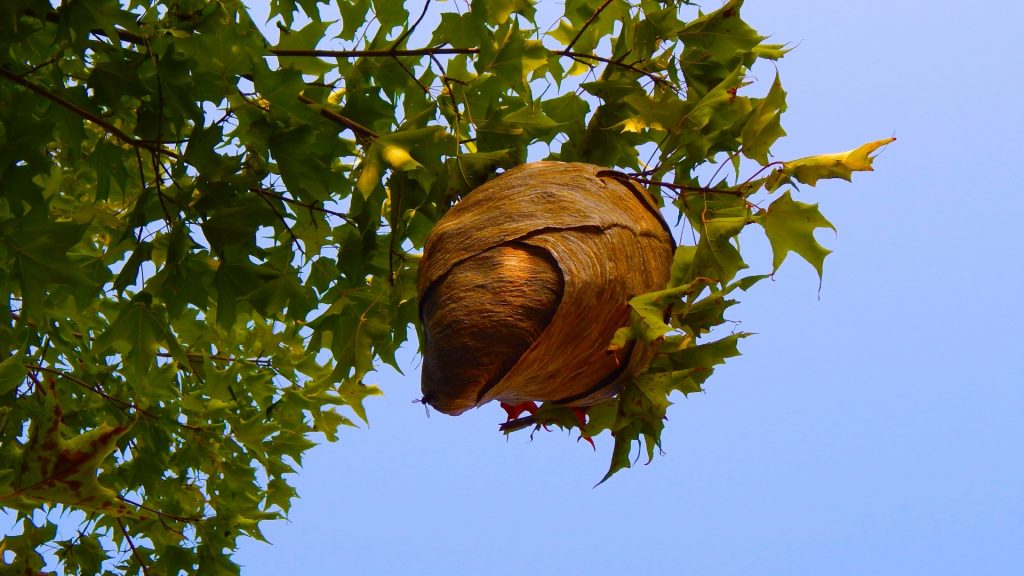
It depends on the type of wasp and species. Solitary wasps usually construct nests in hollow stems, natural cavities, and underground burrows with some are made entirely out of mud and clay. Whereas social wasps build nests out of paper
How Long Do Wasps Live?
Although life cycles vary, most wasps live between two weeks to just over a month as fully grown adults, but a few species live closer to six weeks before dying. Wasp queens can live much longer, with some surviving as long as an entire year to repopulate the hives.
Different Types of Wasps
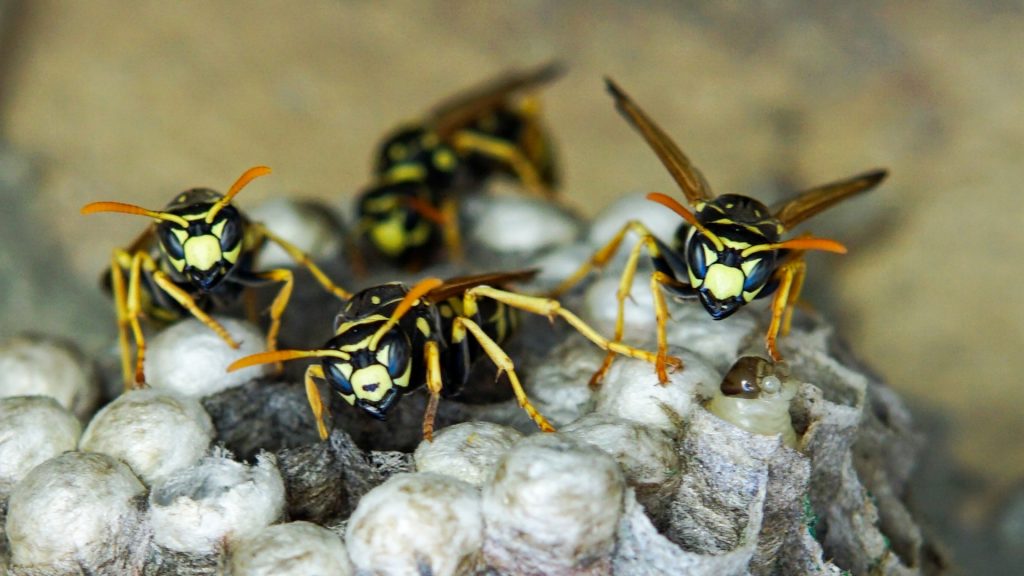
Scientists separate all wasps into two groups:
- Solitary wasps. The most populous; they don’t form colonies and usually grow larger than social wasps. A solitary wasp will also use its stinger for hunting prey, while a social wasp only uses its stinger only for defense.
- Social wasps. Make up only about 1,000 species of wasps. They form colonies, some holding as many as 5,000 wasps. Queens are the only social wasps that survive the winter; they hibernate and repopulate the colony the following year.
Some of the most common wasps found in North America include:
- Paper Wasp
- Yellowjacket Wasp
- Bald-faced Hornet wasp (not a true hornet)
- Red Wasp (a type of paper wasp)
- Mud dauber
- European Hornet (the only true hornet in North America)
Related: What to Do With a Wasp Sting? | All You Need to Know!
What Do Wasps Eat?
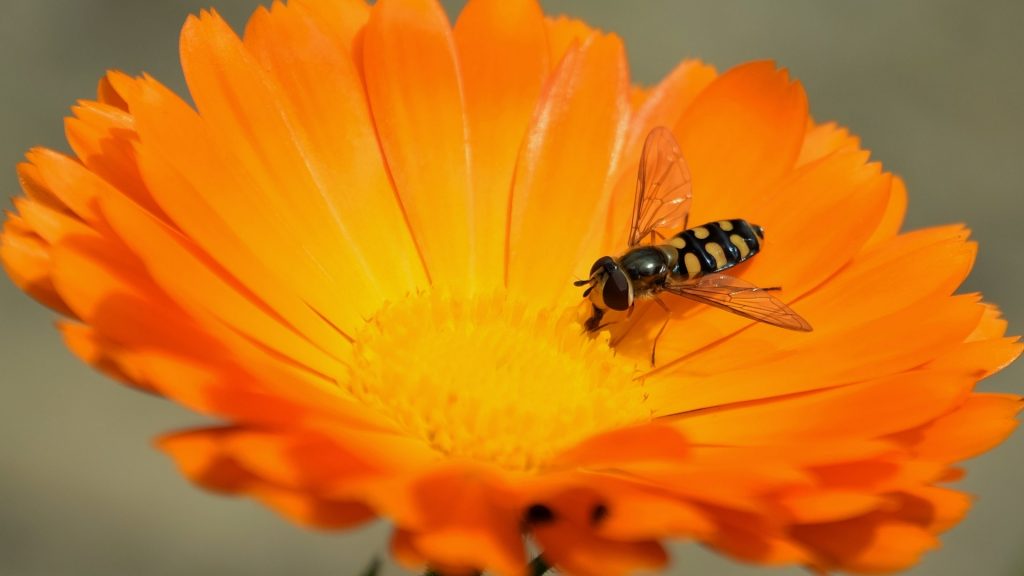
Overall, most wasps’ favorite food is nectar, with juice from fruits coming in at a close second. People frequently claim they see wasps eating wood, but in reality, they aren’t eating the wood. Instead, they’re chewing off small pieces and carrying them back to build their nests.
Wasps also enjoy honey, plants, sap, and even some human food. They’re mainly attracted to sweet foods, but some also eat spiders, insects, caterpillars, and even dead things. Moreover, wasps bring back meat to their nests and feed them to their larvae, but adults don’t eat them.
How Do Wasps Eat?
Wasps have mandibles that allow them to cut, bite, and chew just as humans do. If they’re eating meat or other solid foods, they use these mandibles to do it. However, other parts of their mouths act like a suctorial proboscis. They use these parts for drinking nectar and consuming pollen and other less solid food.
Related: Do Wasps Make Honey? | How Do Wasps Eat and Their Eating Habits
What Do Wasps Like To Eat?
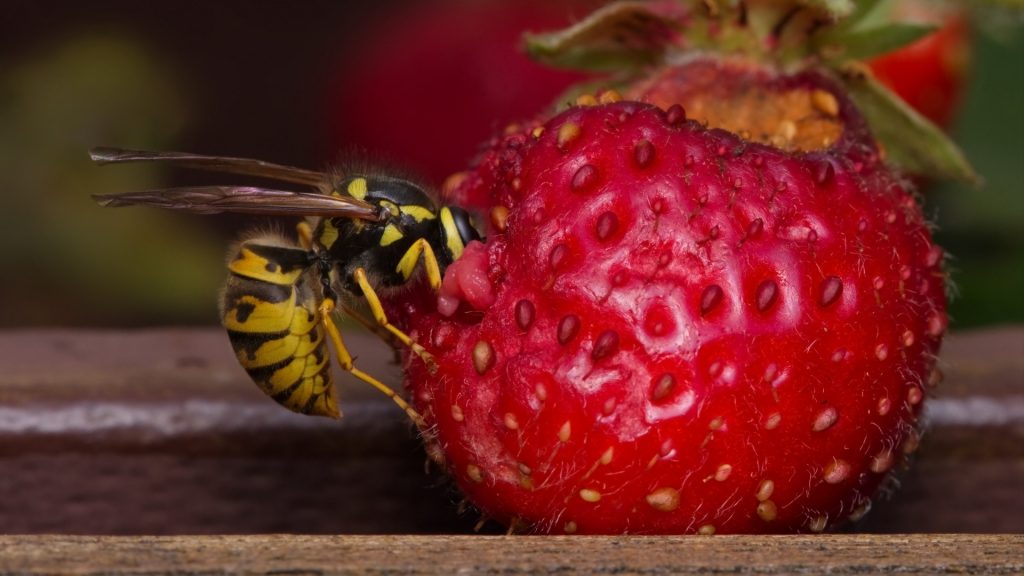
Let’s look at some of the most frequently asked questions about wasps’ eating habits:
- Do wasps eat meat? Yes, some do, predominantly yellow jackets. Nonetheless, they cannot survive solely on meat; they should still consume sugar and water. Wasp larvae, on the other hand, survive exclusively on meat.
- Do wasps eat bees? Yes, again, yellow jackets are particularly fond of both honey and honey bees. Not only that but they also prey on other insects, including caterpillars.
- Do wasps eat wood? Most of the time, wasps only chew the wood and use it to build nests, similar to ant behavior. However, there are some species that not only live in wood but also feed on it. An example is the horntail wasp.
- Do wasps eat caterpillars? Yes, meat-eating wasps are fond of caterpillars. They also kill them and use them to feed their larvae.
- Do wasps eat aphids? Yes, both adult and larval wasps love aphids. In fact, several parasitoid wasp species inject their eggs into aphids, making them hosts for their larvae.
- Do wasps eat ants? Wasps don’t usually eat ants, but they may kill them and feed them to their larvae. The bone-house wasp is a regular hunter of ants for this purpose.
- Do wasps eat flies? Yes, but only seldom. Hornets and smaller-sized wasps, in particular, love consuming flies and other flying insects.
- Can wasps eat through brick? No, though potter and mason wasps sometimes make their nests in pre-existing cracks and holes in brick. They do not eat the brick itself, however.
- Do wasps eat apples on trees? Yes! Wasps love fruit of all kinds! Wasps are able to excavate holes into apples hanging on trees, causing significant damage. This is why it’s essential to protect your fruit trees.
How Often Do Wasps Eat?
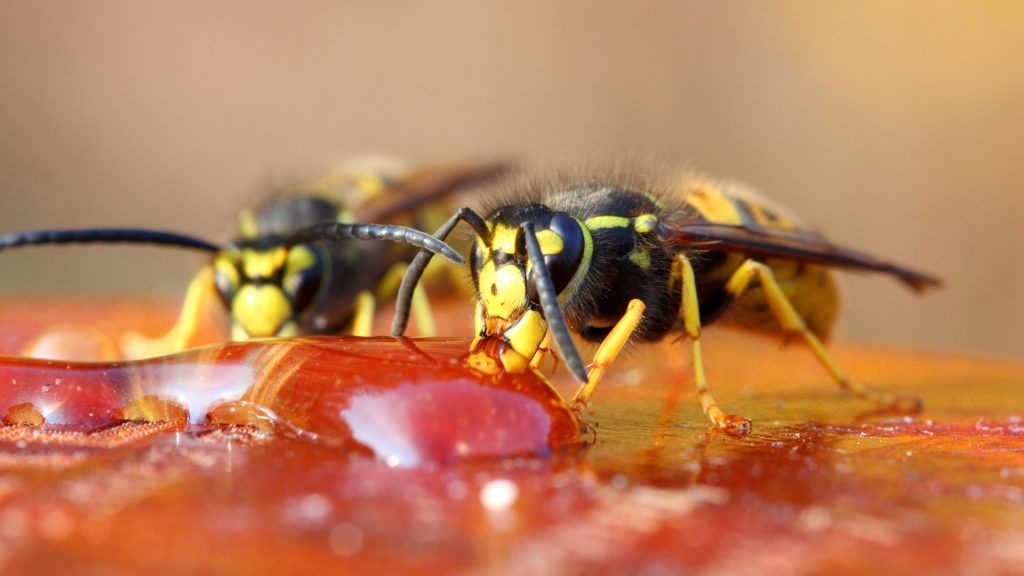
During the spring and summer, adult wasps spend most of the daylight hours eating and foraging food. They settle down at night and don’t do as much flying, feeding, or foraging. When the weather turns cooler in the fall, most worker wasps die. The queens are the only ones that survive, hibernating through the winter.
Related: Do Wasps Attack at Night? | Important Facts!
What Do Baby Wasps Eat?
Wasp larvae have no wings and cannot leave the nest. They eat only what the adult wasps bring back to them, usually insects or spiders they’ve stung and paralyzed, or sometimes killed. Some species of wasp larvae hatch inside dead spiders’ abdomens and consume the spiders as they grow.
Wasp Control
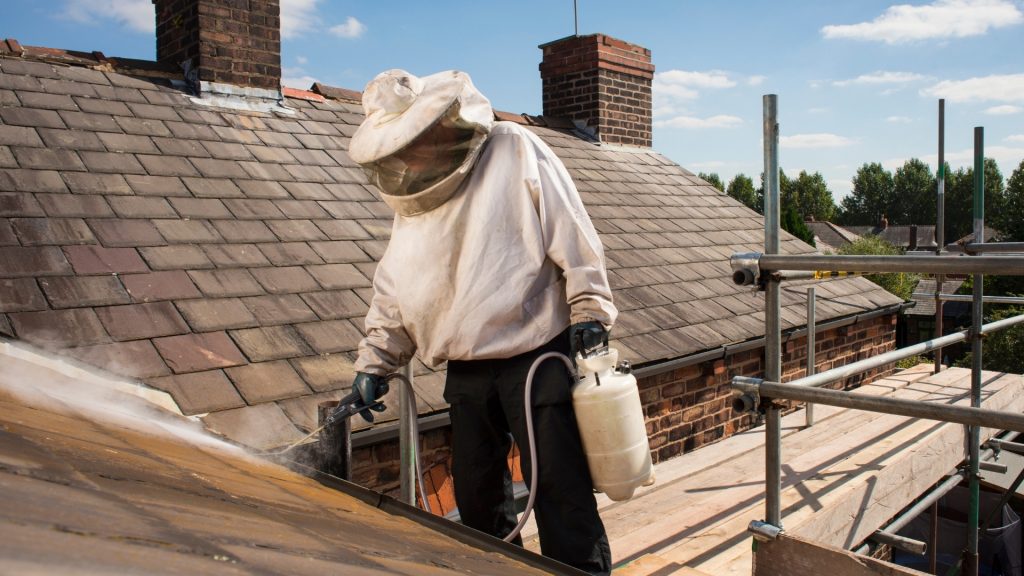
Although wasps are beneficial to the ecosystem and most don’t sting humans, we still don’t like them. When we see wasps or wasp nests near our home, our first instinct is usually to get rid of them. Here’s how you do it:
How To Get Rid of Wasps?
This step-by-step guide will show you exactly how to get rid of wasps.
1. Identification
The first step to getting rid of wasps is identifying what species are living on your property. Some wasps aren’t dangerous to people, and since they’re beneficial to the environment, you may decide to let the harmless ones stay.
Additionally, some wasps, like yellow jackets, are aggressive, and if you’re dealing with them, you’ll want to know upfront so you can be more careful during the process.
2. Decide Who’s Going To Handle It
After you’ve identified your wasps, the next step is to determine whether you’re going to tackle the nest yourself or hire a professional. If you’re severely allergic to wasp stings, don’t attack the nest yourself! It may cost you more to hire a professional, but the price is sure to be less than an expensive hospital bill if you get stung.
3. Find the Nest/Colony
If you’ve decided to hire a professional, make the call, and your work is done. However, if you plan to tackle the nest yourself, the next step is finding it. You can, of course, kill individual wasps one by one, but colonies can hold up to 5,000 wasps, so this isn’t going to be an efficient use of your time.
Suit up in protective gear—long sleeves, long pants, closed-toed shoes, and gloves—and search for the colony. Researching your species of wasp to see where they most commonly build their nests should help you locate it faster.
4. Spray the Nest With Insecticide
Finally, spray the nest with a powerful insecticide, preferably one that allows you to apply from a safe distance so as not to risk their wrath. Be sure to coat the nest thoroughly; saturate it from every side. That allows the insecticide to penetrate through the nest’s walls and kill the wasps inside.
Here are some effective products you can try:
No products found.
- BLANKETING FOAM: Foaming aerosol kills listed insects by contact
- UP TO 20 FOOT JET SPRAY: Treat the nest from a distance
- CONTROLS WASPS AND HORNETS: Designed to kill wasps, hornets, mud...
- USE OUTDOORS: Focus spray on the nest at sunset when insects are...
- ACTIVE INGREDIENT: Tetramethrin, Permethrin & PBO
- KILLS ENTIRE NEST FROM A DISTANCE: Able to effectively kill...
- KEEPS YOU SAFE : No harsh fumes & Non-conductive up to 47,300...
How To Get Rid of Wasp Nest?
Below are the steps for successfully getting rid of wasp nests:
- Identification
- Determination of who’ll do the job
- Tracking down the nest
- Suiting up (wearing protective clothing and equipment)
- Spraying the nest with insecticide
Related: How to Get Rid of a Black Wasp and Prevent It From Coming Back? | The Effective Guide
How To Get Rid of Wasps Naturally?
When it comes to aggressive wasps and large colonies, we usually encourage them to use powerful insecticides so that they don’t get stung, but for those of you who insist on using natural remedies, here are some that might work:
- A mixture of dish soap and water
- Adding mint plants around your home
- Using diluted peppermint oil or spearmint oil spray
- 100% PURE & NATURAL PEPPERMINT OIL - Handcraft Blends oils are...
- PREMIUM GRADE & QUALITY – All Handcraft Blends Essential Oils...
- HIGH QUALITY GLASS BOTTLE AND DROPPER – Our essential oil comes...
- VERSATILE FOR DIY PROJECTS – Perfect for aromatherapy, massage,...
- BOTTLED IN THE USA – Our oils are sourced from the best regions...
- 100% PURE & NATURAL SPEARMINT OIL - Handcraft Blends oils are...
- PREMIUM GRADE & QUALITY – All Handcraft Blends Essential Oils...
- HIGH QUALITY GLASS BOTTLE AND DROPPER – Our essential oil comes...
- VERSATILE FOR DIY PROJECTS – Perfect for aromatherapy, massage,...
- BOTTLED IN THE USA – Our oils are sourced from the best regions...
Still, if you’re dealing with aggressive wasps, you may want to take the more successful and efficient method which is the application of pesticides. Save yourself the time and effort!
Related: Powerful Homemade Wasp and Bee Sprays (with Recipes)
Are There Any Benefits of Wasps?
There’s no denying that a wasp sting hurts, but despite their potential to hurt us, wasps do a lot of good, too. Unlike bees, they aren’t extensive pollinators, although the queens play an essential role in pollination in some areas. However, they do a great job of keeping the insect population low.
In fact, according to the Natural History Museum’s, social wasps in the United Kingdom contributed to the capture of about 14 million kilograms of insect prey every summer. That’s a whopping amount of bugs and come to think of it, without wasps, these pesky insects would be causing havoc to our lives!
List of Sources
Bente, C. (2023). Wasps – Beneficial and Pollinators.
Biddinger, D. (2017). Tree Fruit Insect Pests – Yellow Jackets and Hornets.
Breece, C., Wyns, D., Sagili, R. (2018). Protecting Honey Bees from Yellowjacket Wasps.
Calles-Torrez, V., McGinnis, E., Beauzay, P., Walton, N., Landis, J., & Knodel, J. J. (2019). Smart Gardening: Know the insects that look like bees.
Jesse, L. (2009). Yellowjacket Wasps Look for Sweet Things to Eat in the Fall.
Main, D. (2014). This Wasp Eats Spiders And Stacks Up Corpses Of Stinging Ants.
New York City Government. (n.d.). Wasps.
Osterloff, E. (n.d.). What do wasps do?
Schuh, M. (2023). Wasps are a gardener’s friend.
- Bed Bug Surge 2025: How to Detect, Prevent, and Safely Eliminate Infestations in Top U.S. Cities - June 18, 2025
- Asian Needle Ants Invade US Homes: 2025 Guide to Identification, Risks, and Effective Control - June 11, 2025
- New World Screwworm Alert: How US Livestock Owners Can Prevent Outbreaks and Protect Herds [Summer 2025 Update] - June 8, 2025




